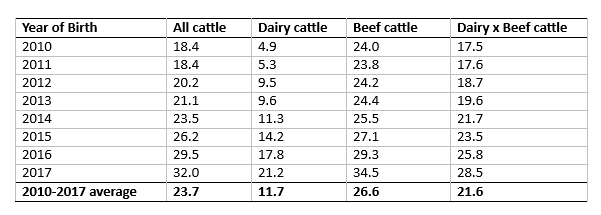
BCMS
The Cattle Tracing System (CTS) maintained by the British Cattle Movement Service (BCMS) contains information on births, deaths and movements of all cattle in the UK. It is also a source of cattle pedigree information as it is compulsory to include dam information on the passport. It also has space for sire information, but unlike dam information, it is not a compulsory field. Levels of sire recording on passports have been historically low, but we have seen a steady increase in the percentage of sires recorded since 2010 (see Table 1).
Table 1: Percentage of animals with sire details recorded in BCMS since 2010

Estimation of genetic potential
Estimated Breeding Values (EBVs) allow us to assess the genetic potential of an animal for breeding. Improving genetic potential has cumulative and permanent benefits to the cattle industry, and particularly in the dairy industry we have seen that utilising EBV information when making breeding decisions has had a positive impact across a range of traits, including not only production traits, but also health and fertility.
EBVs are calculated using a combination of performance data and pedigree, which is used to detect genetic links between individuals. In the beef industry, where performance recording is managed by individual breed societies, with evaluations carried out by a range of different partners such as BREEDPLAN, Signet and EGENES. Uptake of performance recording varies by breed, and pedigree information is restricted to animals registered with the relevant breed society. A different structure is seen in the dairy industry, where the majority of performance recording is undertaken by milk recording organisations and breed societies, who also collect information on pedigree. This data is then shared with AHDB Dairy, who work alongside EGENES to produce the UK dairy genetic evaluations for all dairy breeds.
EBVs from commercial phenotype data
There is a vast amount of routinely recorded data across the cattle industry that could be harnessed for genetic evaluations. One example of this is carcase trait data collected by abattoirs. By combining this phenotypic data with pedigree information sourced from BCMS, AHDB have worked alongside EGENES to produce the National Beef Evaluations launched in November 2018, and the Dairy Carcase Index, launched in April 2018.
The abattoir data shared with SRUC for these EBVs and index covers approximately 40 per cent of the national kill. However, at the present time only 50% of the data provided by abattoirs is completely useless for genetic evaluations, because no sire was recorded within BCMS. In some cases we are able to determine sire based on pedigree and insemination data provided by breed societies and milk recording organisations, but we have no other way of accessing pedigree data for commercial animals.
BCMS itself also provides further opportunities to harness routinely recorded data for genetic evaluations. Information on dead or alive status for tagged calves is being used to produce EBVs for calf survival in Limousin and dairy breeds, with other beef breeds in the pipeline. Other traits that we intend to explore via the BCMS database include longevity and calving interval, and alongside APHA data EBVs for bTB resistance in beef cattle are also in development.
Barriers to sire recording
We acknowledge that sire recording is not always possible, for example when more than one bull is left to run with the herd, or mixed straws are used for insemination. AHDB have developed a suckler breeding plan to help farmers record sires used on groups of animals which is freely available to order.
We also recognise that the current BCMS system is unsuited to recording dairy sires, as there is high usage of foreign bulls whose identification numbers are not recognised by BCMS. However, with 50% of UK beef now originating in the dairy herd, it is vital that beef sires are recorded in BCMS wherever possible. This will improve both the breadth of bulls for whom EBVs are available, and also improve the accuracy of evaluation. If we can achieve this, we will see faster genetic progress within the beef industry, and have a positive impact on the productivity and profitability on farm.
Benefits of recording
Improving your choice of beef genetics
Genetics companies react to market requirements. The availability of semen for a wide range of easy calving beef bulls has been improving since demand for beef genetics in the dairy herd. Successfully improving the breadth and accuracy of genetic evaluations such as the AHDB National Beef Evaluations and the Dairy Carcase Index will allow genetics companies to source bulls that best fulfil customer requirements. Demand information. Not only will genetics companies respond to overall customer demand, a 2015 survey by AbacusBio showed that a key reason for a farmer not providing EBV information during the sale or purchase of animals was due to lack of interest from the customer. However, the key reason for farmers not requesting EBV information was because it wasn’t provided by the seller. Greater communication between genetics providers, bull breeders and bull buyers is needed in order to create an environment where the display of genetic information is standard.
The benefits of sire recording do not stop at an individual level. Even if you don’t directly use EBVs when making breeding decisions, you can still make a difference by recording known sires. More data would mean greater reliability of EBVs across more sires and thus gains made by those routinely using EBVs to inform their selection decisions will improve cattle performance across the whole industry.
Accessing premiums
Multiple supply chain partners offer premium schemes for animals that fit market requirements. A number of these current premiums are based on named sires, so recording sire information through BCMS will provide access to these premiums. Think to the future as well as current trends. As consumers become ever more attentive to where their food comes from, traceability is becoming an important issue. With retailers already working to trace their product back to the farm and the animal, knowing the full pedigree for that animal could be the next stage.